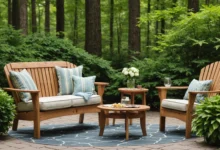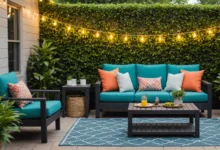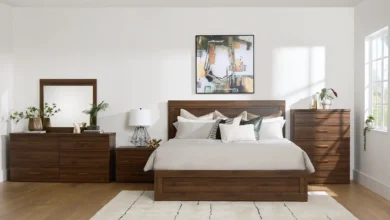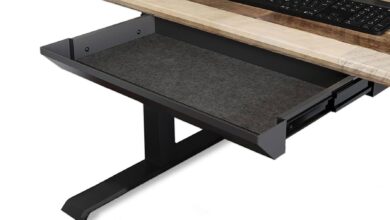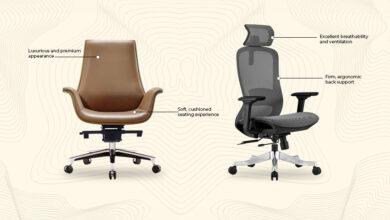Farmhouse Dining Tables: Rustic Charm Meets Modern Dining
Looking for a dining table that screams comfort and warmth? A farmhouse style table offers a welcoming atmosphere for family meals and casual gatherings. From rustic charm to modern interpretations, these tables are proving incredibly popular for their ability to seamlessly blend with various decor styles, making them a fantastic choice for creating a cozy and inviting dining space.
Contents
- 1 Finding the Perfect Farmhouse Dining Table: A Comprehensive Guide
- 2 Understanding the Farmhouse Dining Table Aesthetic
- 3 Choosing the Right Size
- 4 Material Matters: Wood vs. Painted vs. Other Options
- 5 Exploring Different Shapes and Styles
- 6 Consider the Table’s Legs
- 7 Choosing the Perfect Top
- 8 Seating Options and Considerations
- 9 Budget and Availability
- 10 Maintaining Your Farmhouse Dining Table
- 11 Choosing the Right Farmhouse Dining Table Size
- 12 Materials Matter: Wood, Metal, and More
- 13 Exploring Farmhouse Dining Table Styles
- 14 Farmhouse Dining Table Top Shapes and Sizes
- 15 Exploring Farmhouse Dining Table Colors and Finishes
- 16 Selecting the Right Farmhouse Dining Table Chairs
- 17 Incorporating Farmhouse Dining Table Accessories
- 18 Budgeting for Your Farmhouse Dining Table
- 19 Bringing it All Together: Design Considerations
- 20 Choosing the Right Farmhouse Table Style
- 21 Table Size and Shape Considerations
- 22 Budgeting for Your Farmhouse Table
- 23 Seating Arrangements and the Tabletop
- 24 Maintenance and Durability
- 25 So, What Are You Waiting For?
Finding the Perfect Farmhouse Dining Table: A Comprehensive Guide
So, you’re looking for a farmhouse dining table? Fantastic! This style is all about warmth, functionality, and a touch of rustic charm. But with so many options out there, where do you even begin? This guide will break down everything you need to know to find the perfect farmhouse dining table for your home.
Understanding the Farmhouse Dining Table Aesthetic
Farmhouse style dining tables are all about that cozy, lived-in look. Think exposed wood, simple lines, and a touch of rustic charm. The key elements often include natural wood tones (think light oak, reclaimed wood, or even painted finishes), sturdy construction, and a relaxed, casual vibe. Imagine gathering around a table made of reclaimed wood, enjoying hearty meals with your loved ones. This style isn’t about fussy details, it’s about creating a space that feels inviting and comfortable. The materials often used – like reclaimed wood or rough-hewn wood, even painted finishes – contribute to this rustic, yet stylish aesthetic. You can find variations in the style, from tables with simple, clean lines to those with more elaborate details, but the underlying principle of comfort and functionality remains a constant. Ultimately, the perfect farmhouse table for you will depend on your personal taste and the overall design scheme of your home.
Choosing the Right Size
Size is crucial when choosing a farmhouse dining table. Measure the space you have available, taking into account not just the table itself but also the surrounding chairs, walkways, and any other furniture in the room. A small table may feel cramped, and a large table may overwhelm your space. Consider how many people you typically eat with, plus guests. Do you need to fit larger groups or accommodate occasional dinners with family and friends? Think about the layout of your room and how the table will fit into the flow. A space too small can create a cramped and uncomfortable environment, while a space too large can make the room seem less welcoming and less intimate. Take careful measurements and use a floor plan or even a digital room layout tool to help you visualize the table’s size within your dining space. A dining table that is too small can be frustrating if you have to constantly shift chairs or accommodate guests. Similarly, a table that is too large can make the room feel cramped and cluttered.
Material Matters: Wood vs. Painted vs. Other Options
Farmhouse tables offer a wide array of material choices. Solid wood, often reclaimed or light oak, is a classic choice. The warmth and natural beauty of the wood really shine through in this style. It offers a timeless appeal, adding an organic touch to your dining area. Painted tables add a striking pop of color and allow for more playful customization. Painted finishes can create a cheerful and inviting atmosphere and make the table look distinct and unique. Other options include composite materials, which might be a budget-friendly alternative to wood but could lack the rustic warmth. Consider your budget, the overall aesthetic of your home, and the durability you require when making your decision. Your preferred material can influence the atmosphere of your entire dining room and contribute to the overall ambiance you’re aiming for.
Exploring Different Shapes and Styles
Beyond the basic rectangular table, explore the versatility of farmhouse designs. Oval tables, round tables, and even tables with irregular edges or shapes, can all work within the farmhouse style, depending on your space and seating needs. The shape of your table can significantly impact the flow and comfort of your dining area. Consider a round table if you want a more intimate and collaborative feel. A rectangular table offers more seating capacity, ideal for larger gatherings. An oval table strikes a balance between these two and might be ideal for a dining room with a less traditional layout. Ultimately, choose the shape that best complements your dining space and personal preferences.
Consider the Table’s Legs
Farmhouse table legs often feature a simple, sturdy design, such as exposed wood or metal. The legs are an essential part of the table’s visual appeal and often reflect the overall aesthetic of the furniture. The design of the legs can range from simple block legs to more elaborate styles, all adding to the character and style of the table. Solid, robust legs indicate durability and longevity, a trait that’s important for a piece of furniture that will be used frequently. Consider the visual impact of the legs and how they enhance the overall style of your dining room. The legs should contribute to the table’s overall aesthetic appeal and not detract from it.
Choosing the Perfect Top
The tabletop itself is a defining feature of the farmhouse dining table, influencing its look and feel. From thick slabs of reclaimed wood to smooth, painted finishes, the choices are vast. The tabletop’s style, thickness, and material directly affect the table’s durability, weight, and overall aesthetic. A thicker tabletop will feel more substantial and provide a more sturdy surface. Its finish, whether smooth, distressed, or textured, will influence the table’s overall look. Think about the table’s potential longevity, how it will hold up to daily wear and tear, and how it fits with the other furnishings in your dining room. The choice of tabletop material should be consistent with the rest of the furniture and design elements in your dining room.
Seating Options and Considerations
Pairing your table with the right chairs is crucial for a cohesive farmhouse look. The right chairs contribute to the overall comfort and aesthetic. Consider chairs with simple lines, sturdy frames, and comfortable seating. Natural wood tones, or painted in complementary colors to your table will complete the look. The choice of chairs can significantly affect the atmosphere of your dining room, so choose carefully. Consider the overall height and proportions of the chairs in relation to the table. The combination of table and chairs should contribute to a balanced and visually appealing dining space.
Budget and Availability
Farmhouse dining tables come in various price ranges. Research different retailers to compare prices and quality. Look for deals and sales to help optimize your budget. Additionally, consider where to buy your table – online retailers or local furniture stores may offer different price points, options, and delivery times. Factor in the delivery costs and potential assembly requirements when calculating your budget. Shop around and compare prices from different sources before making your purchase. This will help you get the best value for your money and find the ideal table for your home.
Maintaining Your Farmhouse Dining Table
Proper maintenance is crucial to preserving your farmhouse dining table’s beauty and longevity. Cleaning and protective treatments are crucial for ensuring the table’s long-term health. Regular cleaning to remove spills and marks will help maintain the table’s condition. Applying a protective sealant, if needed, will protect the table from damage caused by moisture or other factors. Following the manufacturer’s instructions for cleaning and maintenance is crucial for maintaining the table’s condition and ensuring its durability. Be aware of the specific care requirements for your chosen materials, like wood or composite. Preventative measures, like using placemats and coasters, can extend the table’s lifespan and keep it looking its best.
Choosing the Right Farmhouse Dining Table Size
Finding the perfect farmhouse dining table size is crucial for a comfortable and functional space. It’s not just about aesthetics; it’s about the practicalities of everyday life. A table that’s too small can feel cramped, leading to awkward mealtimes and frustrated diners. Conversely, a massive table that dwarfs your room will look out of place and potentially feel overwhelming. Consider the number of people you frequently dine with. For intimate gatherings of just two or three, a smaller table, perhaps 48 inches long, might suffice. However, if you host large family dinners or entertaining, a table that comfortably seats eight or more, with a generous length of 72-96 inches, will be better. Measure your dining area carefully. Leave enough room for chairs to be pulled out without hitting walls or other furniture. The general rule of thumb is to allow about 30 inches of space per person, including chair swing room. Also think about the overall style of your room and how much space you have to work with. A smaller table in a large room might feel lost, while a massive table in a tiny room will feel overwhelming. You want your dining table to be a focal point, not a distraction. Don’t forget to factor in any future needs. If you anticipate having more people over in the future, a larger table might be a better long-term investment. Ultimately, the best size for your farmhouse dining table hinges on your specific needs and your space’s dimensions.
Materials Matter: Wood, Metal, and More
The material of your farmhouse dining table plays a significant role in its durability, aesthetic appeal, and overall feel. Wood, a classic choice for farmhouse style, offers warmth and character. Different wood types offer varying degrees of durability and maintenance. Oak, known for its strength and beauty, requires a bit more upkeep with regular oiling or waxing to preserve its rich look. Pine, on the other hand, is often more affordable and provides a slightly softer, lighter aesthetic. It might need more protection from moisture but is still a popular choice. Solid wood tables are usually more expensive but also more resilient and can be passed down through generations. Consider how much time you’re willing to spend on maintenance. Metal, especially iron, can add a touch of rustic charm. A wrought iron table brings a unique elegance and a certain weight that suggests substantial quality. However, metal tables can be more susceptible to rust if not properly cared for. Glass and tempered glass tables can be a stylish addition, though they demand a more careful cleaning routine. They can be sleek and modern while still maintaining the essence of farmhouse charm. Combined materials, such as a wooden tabletop with metal legs, can deliver a beautifully blended aesthetic. This combination can offer the best of both worlds in terms of function and style, depending on your space and preferences. Careful consideration of the materials, durability, and maintenance needs will lead you to the perfect farmhouse dining table for your home.
Exploring Farmhouse Dining Table Styles
Farmhouse dining tables come in a variety of styles, each with its own unique character. The classic "rustic" style often features rough-hewn wood, exposed beams, or a distressed finish. These tables evoke a sense of warmth and comfort. A "modern farmhouse" approach blends the rustic appeal with clean lines and contemporary elements. This approach might feature sleek metal legs or a more minimalist design, but still retains the cozy, welcoming farmhouse feel. The “industrial farmhouse” blends a rustic vibe with the strength and durability of metal. These tables often combine natural wood with metal accents, providing a sturdy and visually interesting combination. Each style has its own specific character and brings a unique personality to your dining area. Be sure to consider the overall aesthetic of your home when choosing a style. A table that doesn’t fit the mood of your room can quickly disrupt the harmony. Sometimes a simple, solid-wood table is the perfect choice if your room already features many bold design elements. Consider using existing decor to inspire your choice of dining table styles. Matching existing furniture, colors, or textures can create a cohesive and visually appealing space. Think about how the table will fit in with your kitchen décor or the living room arrangement. Consider the lighting and other architectural features in the area as well.
Farmhouse Dining Table Top Shapes and Sizes
Choosing the right shape and size for your farmhouse dining table can significantly impact the overall feel of the space. Rectangular tables are the most common choice, offering ample seating for larger gatherings. They are also highly versatile, fitting into various dining areas and maintaining visual balance and proportion with the surrounding environment. Square tables can be equally functional and offer a more compact, yet still welcoming aesthetic. They provide a sense of organized formality. Round tables, with their flowing lines, often create a more relaxed and intimate atmosphere, perfect for smaller families or those who desire a sense of togetherness. The shape you select should reflect how you use your dining space. If you frequently host large dinner parties, a rectangular table is likely the better choice. If casual family meals are more your style, a round table might be a better fit. The size of the table is also crucial. Measure your space carefully, ensuring that there’s ample room to accommodate chairs, traffic flow, and other furniture in the area. If the table feels too large, consider opting for a more compact configuration. Remember to factor in the size of your chairs to determine the necessary space. The right shape and size table can enhance the experience, making it easy to dine in a comfortable, cohesive space.
Exploring Farmhouse Dining Table Colors and Finishes
The colors and finishes of your farmhouse dining table can significantly impact the overall mood and aesthetic of your dining area. Natural wood finishes, such as light oak or pine, offer a warm and inviting atmosphere. These hues often blend seamlessly with various décor styles and create a comfortable, relaxed environment. Darker wood tones, like walnut or cherry, add a touch of elegance and sophistication to your space. They create a classic look and complement various decorating styles, depending on the rest of your decor. Consider using lighter or darker colors to contrast your walls to create balance and dimension. Painted tables offer a great opportunity to add a personal touch and inject color into the space. A vibrant blue or a warm yellow can add a pop of personality to the room, making it uniquely your own. Neutral colors, such as beige or gray, provide a versatile backdrop that complements various design elements and decorating themes. Remember to consider how the color of your table will interact with the colors of your walls, chairs, and other furniture in the room. A well-chosen color can elevate the overall aesthetic. Choose a finish that complements the overall style and atmosphere you want to create in your dining space.
Selecting the Right Farmhouse Dining Table Chairs
The chairs you choose to accompany your farmhouse dining table are just as important as the table itself. Choose chairs that complement the table’s style and material. If your table has a rustic, wooden feel, consider chairs crafted from similar materials or in a similar color palette. If your farmhouse table has a modern feel, sleek metal or upholstered chairs could be a great pairing. Consider the comfort level of the chairs. You’ll be spending time sitting at your dining table, so comfort is a key factor. The height of the chairs should be proportional to the height of the table’s surface. Choose chairs that have a comfortable back and supportive seat cushions. The chairs’ durability is also important to consider, especially if you anticipate frequently hosting guests. Look for chairs that are constructed from strong and reliable materials. Chairs should not only complement the style and look of the table, but also the atmosphere of your home. Think about the lifestyle you lead and how frequently you dine. Comfort and functionality go hand-in-hand when choosing chairs.
Incorporating Farmhouse Dining Table Accessories
Farmhouse dining tables are perfect canvases for accessories that add personality and functionality to your space. Decorative elements, like woven placemats, can provide a warm and inviting touch. A set of beautifully crafted ceramics or simple wooden bowls could bring a unique charm to the table. Candlelight and flowers can enhance the ambiance and create a welcoming atmosphere. Consider using vintage-inspired items to inject a dash of old-world charm into your table setting. Thoughtful accessories can turn an ordinary meal into a delightful experience. Don’t be afraid to experiment with various textures and patterns to add visual interest to your table. Adding a collection of vintage-inspired items can contribute to a special, personal touch and unique atmosphere. These elements will complement your style and create a warm, inviting atmosphere. A carefully selected collection of accessories can take your dining space from ordinary to extraordinary.
Budgeting for Your Farmhouse Dining Table
The cost of a farmhouse dining table can vary significantly depending on the materials, size, and complexity of the design. Solid wood tables with intricate details often come with a higher price tag. However, more affordable options are available. Consider your budget early in the process, as it will influence your choices in terms of materials, design, and overall style. Compare prices from different retailers and consider the long-term value of the table. A more durable table may cost more upfront but could potentially save you money in the long run. Look for sales or discounts, or consider buying used or refurbished options if your budget is tight. Building the table yourself is also a practical way to save money, though it requires some woodworking skills and tools. Remember that the table is an investment that will serve you for many years, so spending a little extra for quality and longevity might be worthwhile. Also, factor in the cost of any necessary accessories, such as chairs and linens.
Bringing it All Together: Design Considerations
The design of your farmhouse dining table needs to seamlessly integrate into your existing home décor. Consider the existing color palette of your room. Choose furniture that complements the style, whether rustic, modern, or somewhere in between. Make sure the table size and shape complement the dining area, considering space limitations. Your farmhouse dining table should be a part of your overall decor, rather than standing out as an unwelcome addition. The right lighting can dramatically impact the appearance of the table. A well-placed chandelier, or strategically placed lamps, can enhance the ambiance and create the desired mood. Consider using natural light sources as much as possible and consider soft warm lighting, especially during evening meals. The key is to create a space that is both functional and aesthetically pleasing. Think about your overall style – rustic, modern, or a blend – and ensure the table complements the aesthetic. Choose furniture and accessories that enhance the theme of your room to create a cohesive design.
Choosing the Right Farmhouse Table Style
So, you’ve decided a farmhouse table is the perfect addition to your dining space. Now the fun (and sometimes overwhelming) part begins – selecting the *perfect* style. Farmhouse tables aren’t one-size-fits-all. They come in a delightful array of shapes, sizes, and finishes that can really reflect your personal aesthetic. Consider the overall vibe you’re going for in your home. Are you aiming for a rustic, cozy feel? Or perhaps a more modern, slightly-polished farmhouse look? The style you choose will significantly impact the overall ambiance of your dining room. Think about the existing furniture and décor in your space. A dark, weathered wood table might clash in a bright, airy room, while a lighter, painted finish could effortlessly blend into a more contemporary setting. Ultimately, the right style will be one that you feel comfortable and happy with each and every time you use it. Don’t be afraid to mix and match elements. For example, a simple, painted white table can be perfectly complemented with a set of rustic-style chairs. This allows for a customisation that feels more reflective of your unique home. To help you in this important decision, here’s a brief rundown of common farmhouse table styles.
| Style | Description |
|---|---|
| Rustic Charm | These tables often feature reclaimed wood, visible knots, and a naturally worn appearance. They often have chunky legs and a slightly uneven surface. They exude a relaxed, barn-like vibe, perfect for those who embrace the slightly rough-around-the-edges aesthetic. Consider the age and history that could be associated with the wood; have a sense of connection and nostalgia when choosing this style. |
| Modern Farmhouse | A touch more polished, these tables typically use sleek, clean lines, with finishes that range from painted white to darker, modern tones. They often have more geometric shapes in their structure, or simplified designs. They offer a contemporary edge to your home without compromising on the charm of a farmhouse dining experience. If your home’s decor is modern, this style will make your dining space stand out, blending into the overall tone. |
| Painted Elegance | Often a popular choice, painted farmhouse tables can be achieved in a range of colours to complement your home decor. From classic white to bold blues or greens, the possibilities are endless. This option often allows more room to experiment with the overall feel you want to create. This also presents opportunities to personalise the look further with additional features or accessories. |
Table Size and Shape Considerations
The size and shape of your farmhouse table are critical to its effectiveness in your dining room. A table that’s too small will feel cramped and make it difficult to comfortably accommodate guests. Conversely, a table that’s too large might overwhelm the space. Measure your room meticulously to determine the optimal dimensions. Consider the number of people you anticipate hosting most frequently. A table that accommodates 8-10 people is usually a solid choice for most homes. Also, consider the shape of your room. A long, rectangular table works well in a narrow space, while a round table can add a touch of elegance to a more square or circular room. If your room’s layout or design isn’t working with the table dimensions, you may need to adjust other parts of the layout, including seating. This may include moving existing furniture.
Budgeting for Your Farmhouse Table
Farmhouse tables come in a range of prices, from budget-friendly options to more luxurious pieces. Your budget will significantly impact your choices. Reclaimed wood tables, while beautiful, can sometimes come at a higher cost due to the sourcing and materials. Painted tables are often a more affordable option, and you can frequently find good deals. Research different retailers and compare prices. Consider your desired features and what’s important to you in a table. For example, do you prioritize a table with a specific tabletop style or certain leg designs? The materials involved and the added customization will influence the overall price tag. Don’t let a low budget stop you from getting the table of your dreams. Look for sales or discounts; consider buying secondhand; or explore DIY options if you have some handy skills. Be patient and thorough in your search; there are plenty of great finds if you’re willing to put in the effort.
Seating Arrangements and the Tabletop
The seating arrangement around your farmhouse table is as important as the table itself. Choose chairs that complement the table’s style and material, without making the space look too cluttered. Consider the style of chairs. A rustic table might look great with wooden, upholstered, or even leather chairs, whereas a modern table is better paired with simple, streamlined styles. How much seating you need will greatly depend on the size of the table and how frequently you’re expecting to entertain. Think about the placement of the chairs: create a warm and welcoming space. Consider the layout of the chairs; a formal arrangement might be suitable for an elegant dinner party, while a more casual arrangement works perfectly for family meals. The tabletop itself is another key design element. Think about the material. Natural wood, painted surfaces, or even glass are common choices. The finish of the tabletop can greatly enhance the overall aesthetic. Carefully consider what materials work well with the space’s surrounding elements, and your home’s design choices.
Maintenance and Durability
A farmhouse table, especially one made of natural wood, requires some upkeep to maintain its beauty and longevity. Knowing how to properly care for your table is crucial to keeping its value and appeal. If you choose a wood table, you’ll need to regularly clean and protect the surface. Using a wood cleaner and a sealant can help prevent scratches and stains, and maintain the table’s appearance. Consider the frequency of use, as well as the type of food being served on the table. Moisture can be a problem for wood tables, so be mindful of spills. Painted tables also have specific cleaning requirements, and usually can be cleaned with a soft cloth and mild detergent. The durability of your table is just as crucial. Choose materials that stand up to frequent use. If you often have gatherings, a solid and well-constructed table will stand the test of time and remain in good condition, adding lasting beauty to your space.
So, What Are You Waiting For?
Well, there you have it! Hope this little tour of farmhouse dining tables has given you some inspiration for your own space. Now go forth and create that cozy, welcoming dining area you’ve always dreamed of. Thanks for reading, and we’d love to see you back here again soon for more decorating tips and ideas. Happy hunting!



